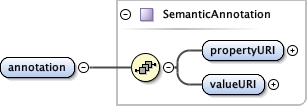<xs:complexType name="SemanticAnnotation">
<xs:annotation>
<xs:documentation>tooltip: Semantic annotation summary: A semantically-precise statement about an EML element. description: The SemanticAnnotation Type contains elements that are used to associate a semantic statement using a property and value from specific formal vocabularies with other elements within EML. For example, one might want to provide the precise set of semantic statements that clarify the measurement semantics of an attribute (variable) within a data set, or associate a specific statement with a data table or dataset. The eml-semantics module defines an 'annotation' element and associated type that can be used within EML resources (dataset, software, etc.), EML Entities (dataTable, spatialRaster, spatialVector, otherEntity), and EML Attributes. They can also be applied within the EML additionalMetadata field to label arbitrary structures within EML, in which case the subject of the annotation is the element listed in the describes element within the additionalMetadata field.</xs:documentation>
</xs:annotation>
<xs:sequence>
<xs:element name="propertyURI" minOccurs="1" maxOccurs="1">
<xs:annotation>
<xs:documentation>tooltip: Property URI summary: The persistent URI used to identify a property from a vocabulary. description: The URI for a property that is drawn from a controlled vocabulary, and that links the subject of this annotation (which is implied by its parent element) to the annotation value. The propertyURI represents a semantically well-defined concept that one wants to apply to an element within EML. These properties should be precisely defined, including defining various relationships to related concepts. Property URIs are typically drawn from formal ontologies that provide well-defined logical semantics and provide for various types of reasoning about equivalence and overlap. Property URIs should be persistent and unique over decades, and the meaning of the URI should be stable over time as well. These URIs are usually constructed using an additional abstraction layer via link resolvers, rather than directly resolving to the term definition itself. Thus, when resolving the propertyURI, software user agents should be prepared to follow multiple redirects before finally resolving the current location of the definition. However, there is no requirement that propertyURIs need to be resolvable, and metadata parsers should expect to find propertyURIs that do not resolve and are only used as unique URIs for the property (i.e., a name).</xs:documentation>
</xs:annotation>
<xs:complexType>
<xs:simpleContent>
<xs:extension base="xs:anyURI">
<xs:attribute name="label" type="xs:string" use="required">
<xs:annotation>
<xs:documentation>tooltip: Property Label summary: A human readable representation of the controlled property. description: A label that provides a human readable representation of the controlled property. The label is often used to represent the controlled property when displaying annotations in software. The label is often redundant with one or more labels that are defined in the controlled vocabulary itself, but is repreated here within the EML document to make it easy for consumers to display the annotation to users. Other labels, including labels in multiple languages, may often be accessible from within the ontology or controlled vocabularly accessible at the propertyURI. Property definitions and relationships to other properties are also typically provided within the vocabularly accessible at the propertyURI. Software and people may be able to resolve the URI to find out the definition and retrieve additional labels and other metadata for presentation to users.</xs:documentation>
</xs:annotation>
</xs:attribute>
</xs:extension>
</xs:simpleContent>
</xs:complexType>
</xs:element>
<xs:element name="valueURI" minOccurs="1" maxOccurs="1">
<xs:annotation>
<xs:documentation>tooltip: Value URI summary: The persistent URI used to identify a value from a vocabulary. description: The URI for a value that is drawn from a controlled vocabulary such as a published ontology or controlled term list. The value represents the object of a semantic statement in which the subject is the containing element, the property is defined by the sibling propertyURI, and this valueURI element represents the object. These values should be precisely defined, including defining various relationships to related concepts. Value URIs are typically drawn from formal ontologies that provide well-defined logical semantics and provide for various types of reasoning about value equivalence and overlap. Value URIs should be persistent and unique over decades, and the meaning of the values associated with the URI should be stable over time as well. These URIs are usually constructed using an additional abstraction layer via link resolvers, rather than directly resolving to the term definition itself. Thus, when resolving the valueURI, software user agents should be prepared to follow multiple redirects before finally resolving the current location of the value definition. However, there is no requirement that valueURIs need to be resolvable, and metadata parsers should expect to find valueURIs that do not resolve and are only used as unique URIs for the value (i.e., a name)</xs:documentation>
</xs:annotation>
<xs:complexType>
<xs:simpleContent>
<xs:extension base="xs:anyURI">
<xs:attribute name="label" type="xs:string" use="required">
<xs:annotation>
<xs:documentation>tooltip: Value Label summary: A human readable representation of the controlled value. description: A label that provides a human readable representation of the controlled value. The label is often used to represent the controlled value when displaying annotations in software. The label is often redundant with one or more labels that are defined in the controlled vocabulary itself, but is repreated here within the EML document to make it easy for consumers to display the annotation to users. Other labels, including labels in multiple languages, may often be accessible from within the ontology or controlled vocabularly accessible at the valueURI. Value definitions and relationships to other terms are also typically provided within the vocabularly accessible at the valueURI. Software and people can resolve the value URI to find out the definition of the value and retrieve additional labels and other metadata about the value for presentation to users.</xs:documentation>
</xs:annotation>
</xs:attribute>
</xs:extension>
</xs:simpleContent>
</xs:complexType>
</xs:element>
</xs:sequence>
</xs:complexType> |

